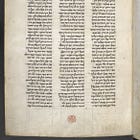Tishrei 5785: The Lives and Afterlives of U-Netaneh Tokef
❤️🔥 The haunting Rosh Hashana piyut U-Netaneh Tokef has a contested backstory, but the complex realities behind its many lives and afterlives tells deep truths, even when they're not what we expect.

Audio (Paid Feature)
Find an audio version of this newsletter here.
In this issue:
One of the centerpieces of Ashkenazi, and some Sefardi, Rosh Hashana and Yom Kippur liturgy is the soul-stirring piyut (liturgical poem), U-Netaneh Tokef (And We Give Strength). Inspiring theological debate among everyone from the casual synagogue-goer to the studied philosopher with its stark theodicy, U-Netaneh Tokef is further enriched by a dramatic backstory that presents it as the composition of a martyred holy figure. It turns out, however, that the story of its composition has many twists and turns of its own. Below, an historical exploration of what we know about U-Netane Tokef, its composition, its transmission, and the legends that surround it.
A word of warning: The following medieval text contains descriptions of disturbing violence.
The Legend of R. Amnon of Mainz
The earliest source preserving the association between U-Netaneh Tokef and R. Amnon of Mainz is from the Or Zarua in the first half of the thirteenth century, at the end of the section on the laws of Rosh Hashana:
מצאתי מכתב ידו של ה"ר אפרים מבונא בר יעקב. שר' אמנון ממגנצא יסד ונתנה תוקף על מקרה הרע שאירע לו וז"ל:
I found in a manuscript of the rabbi Efraim of Bonn bar Yaakov, that R. Amnon of Mainz established U-Netaneh Tokef following the terrible occurrence that befell him, and these are his words:
I wrote about Yitzchak ben Moshe of Vienna, c. 1180-c. 1250, known as the Or Zarua after his famed compilation of Ashkenazi halacha, in my first series:
The Or Zarua is one of the primary sources of Ashkenazi halacha (including of the Rema in his glosses on Shulchan Aruch) and preserves many early customs. Here, R. Yiztchak ben Moshe cites R. Efraim of Bonn, who lived through the Second Crusade in 1147, which also entailed destructive, extreme anti-Jewish violence in Germany. R. Efraim was a halachic authority, paytan (liturgical poet), and chronicler of the effects of the Crusader violence on his community. The Or Zarua goes on to copy from the manuscript of R. Efraim of Bonn—it is a long and detailed story, but one I want to reproduce in whole, as it is unusually rich in highly significant detail:
Keep reading with a 7-day free trial
Subscribe to Stories from Jewish History to keep reading this post and get 7 days of free access to the full post archives.





